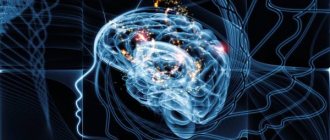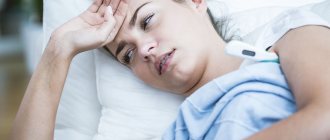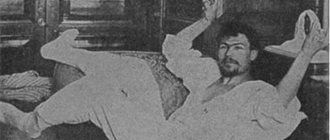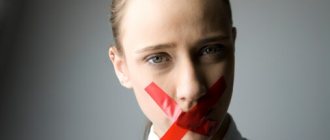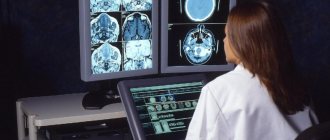Essential tremor is a fairly common hereditary disease of the central nervous system that can occur in children, but mainly develops in older people. The only manifestation of this disease is trembling. Tremors with essential tremor have different localization, severity, prevalence, characteristics and age of onset. Tremors of the head, hands, and tongue are most often observed. Lip tremor is slightly less common in adults.
Symptoms
Most often, essential tremor manifests itself as medium-amplitude and small tremors of the hands, alternating contractions of the flexor and extensor muscles, while muscle tone remains the same. Trembling becomes noticeable during purposeful movements; when approaching the target, its persistence or even a slight increase is observed. Rest tremor is much less common.
As the disease progresses, patients become unable to work. They become unable to serve themselves: due to difficulties in holding cutlery, they cannot eat food or drink water from a mug. Patients are unable to perform many activities that are necessary in everyday life; they need help even with buttoning up buttons and other trivial matters.
Due to the layering of emotional disturbances on the manifestations of tremor, patients develop social maladjustment. Hand tremors with essential tremor occur earlier than, for example, trembling of the lip (in adults) and other parts of the body. For a long time, hand tremors remain the only manifestation of the disease. As a rule, simultaneous trembling of both hands is observed, in rare cases - first only one, then the other.
Upper lip twitching: causes, elimination of discomfort – Suppressed
Chronic fatigue and constant stress lead to nervous and endocrine diseases. When your lip spontaneously pulsates or your eye twitches, you should stop and think about your health.
Upper lip twitching: causes and correction of this condition
The correct name for this phenomenon is facial tic, and the reasons for which the upper lip twitches are extremely varied. A tic is a repetitive, stereotypical movement of a muscle group that is inappropriate in a particular situation and that can be suppressed with great difficulty by willpower for a short time.
Tic is one of the varieties of a broader concept or dyskinesia. This is an unnecessary (redundant) and incomprehensible movement that appears as if “by itself.” Based on the pace of movements, facial tics are distinguished between fast or clonic and slow or dystonic. After the tic has passed, nothing bothers the person, and the level of health does not change.
Facial tics are of concern because they disrupt nonverbal (wordless) communication between people. Facial tics cause the most distress to young people, for whom this appears to be a significant hindrance. Elderly people treat this disorder more carefully.
Prerequisites for the occurrence of facial tics
The face has a lot of facial muscles that differ from skeletal muscles. In skeletal muscles, both ends end in tendons, which are bundled and attached to the bones.
In mimic muscles, only one end of the muscle is motionlessly attached to the bone, and the second has many fibers that are scattered throughout the thickness of the facial skin. Thanks to this feature, a person can wrinkle and raise his eyebrows, frown, laugh, express surprise with his face and all other emotions that he experiences.
There are also circular muscles on the face - around the mouth and eyes. In their structure, they resemble the sphincters of the body; their purpose is to tightly close the eyes and mouth with a muscle ring.
The innervation of the face is carried out by multiple branches of the following nerves:
- trigeminal;
- orbital;
- maxillary;
- mandibular;
- facial.
Each nerve contains motor, sensory and autonomic (sympathetic and parasympathetic) parts. Due to the complexity of their structure and innervation, facial tics can have different manifestations: twitching of the upper and lower lips, wrinkling of the forehead, raising of the eyebrows, squinting of the eyes, spitting, a forced smile, lowering of the corners of the mouth.
The onset of a tic is preceded by a feeling of discomfort, unusual sensations in the face, but there is never pain. With an effort of will you can stop the tic, but not for long.
In order for thyroid movement to occur, the participation of several muscle groups, coordinated with each other, is required. Therefore, a facial tic always appears purposeful. It is almost as harmonious as ordinary purposeful movements and resembles the natural.
Causes
Can be divided into several large groups:
- vascular;
- atherosclerotic;
- tumors and neoplasms;
- lesions of the extrapyramidal system;
- pathological accumulation of copper due to a genetic defect or hepatocerebral degeneration;
- asthenia after somatic diseases;
- neuroinfections;
- simple fatigue and chronic fatigue syndrome;
- lack of vitamins, especially group B;
- neuroses;
- depression;
- long-term use of certain medications;
- diseases of internal organs with metabolic disorders - diabetes, thyroid disease.
Important! The cause of facial tics can only be determined by a doctor during a clinical examination. It is imperative to seek medical help for tics, since the cause can be either harmless and easily eliminated, or very serious and requiring immediate intervention.
Vascular causes
One of the most common, since the blood supply to the brain is an integral part of the general blood flow.
Research has established that our body continuously forms emboli or foreign particles circulating in the bloodstream. These can be particles of atherosclerotic plaques, pieces of blood clots, blood clots, fat molecules, tiny bone fragments formed during fractures, dead cells of infectious agents, gas bubbles.
The diameter of blood vessels in the human body varies in size. The largest vessel, the aorta, has a cross-section of 22 mm, and the smallest capillary has a cross-section of only one hundredth of a millimeter. Blood circulates everywhere - in arteries, veins, and capillaries.
Insoluble dense particles, if present, clog a vessel of suitable diameter. The blockage does not happen forever; protective mechanisms are activated that dispose of the unnecessary “alien”. However, during the blockage, the blood supply to some part of the nervous system is disrupted, and this may well manifest itself as a tic.
Vascular tone is important. One of the common causes of facial tics is vegetative-vascular dystonia, in which vascular tone “plays”, which uncontrollably changes the diameter of blood vessels. Each such contraction-expansion affects general well-being and can impair movement.
Various localizations
More than 50% of patients suffer from head tremors. Often, it is from this localization that the disease begins, and later trembling of the limbs occurs. The head most often moves left and right, less often - down and up, in a circle or diagonally.
Quite often, patients suffer from facial muscles - trembling of the lower lip develops in adults when smiling or talking. Tremor can also manifest itself as isolated, rapid, small twitches of the facial muscles. This type of tremor can occur at an early stage of the disease.
In addition, patients may experience mild tremor of the tongue or eyelids.
Elderly and middle-aged patients who have had the disease for more than 10 years may experience a trembling voice. Sometimes this symptom also occurs in younger people (up to 20 years old) with a disease duration not exceeding 5 years.
Almost a quarter of patients experience trembling of the lower extremities.
Trembling of the entire body is observed in rare cases, most often after physical exertion or emotional outbursts. This symptom may indicate the spread of the disease.
In a small number of patients, diaphragmatic trembling is observed, which can be confirmed by x-ray. When a combination of tremor of the tongue, lips, diaphragm and vocal cords occurs, speech and breathing rhythm may be disrupted.
Regardless of location, trembling intensifies with excitement, significant physical exertion, and hypothermia. When drinking alcohol, there is a decrease in tremor, but it intensifies the next day.
There is a childhood and youthful form of tremor, as well as a form of mature and senile age.
The disease is often diagnosed in patients of childhood and adolescence.
Essential tremor is benign: it does not pose a threat to the patient’s life, but it is constantly progressing, so this disease cannot be ignored.
Doctors at the Neurology Clinic of the Yusupov Hospital provide assistance to patients with essential tremor, aimed at eliminating symptoms that significantly worsen the quality of life of patients. The clinic provides high-quality drug therapy and physiotherapeutic procedures that significantly improve the patient’s condition.
Why the lower and upper lips twitch: what to do and how to treat
Chronic fatigue and constant stress lead to nervous and endocrine diseases. When your lip spontaneously pulsates or your eye twitches, you should stop and think about your health.
Possible causes of twitching
Nervous tics appear due to a lack of vitamins and microelements (glycine, calcium, magnesium), previous traumatic brain injuries, or as a result of infectious diseases (meningitis, meningoencephalitis, encephalitis, leptospirosis). Statistics show that tremors more often occur due to an incorrect lifestyle, non-compliance with work and rest schedules. There are different reasons why the upper lip twitches.
Vascular problems
There are thousands of nerve endings on the face. Pathological manifestations in this area are always painful. The face is innervated by the trigeminal and facial nerves. Constant hypothermia and viral attacks cause inflammation. A problem with blood vessels also cannot be ruled out.
Congenital anomalies of arterioles, capillaries, and their stenoses disrupt the physiological nutrition of the nerve and reduce the supply of nutrients. Malfunctions in the functioning of the nervous system occur. The patient feels numbness and frequent twitching of the upper or lower lip.
When the first symptoms of the disease appear, you should consult a specialist for a general examination.
With hypertension, heart failure, diabetes mellitus, atherosclerosis of the lower extremities, the formation of cholesterol plaques causes atherosclerotic vascular damage.
Blood clots block the lumen of the vessel, the blood supply to the area of the nervous system is disrupted, which can manifest itself as a tic.
Emotional disorders
The media say that all problems are caused by nerves. The reasons why the lower lip twitches may be anxiety or stress. The phenomenon occurs in overly emotional people.
Creative personalities (actors, singers, announcers, presenters) suffer from nervousness as a result of long working hours and constant travel. Scandals and unbalanced actions are perceived by society as bad manners, promiscuity, and star fever.
These are signs of dysfunction of the nervous system.
A popular diagnosis in children is attention deficit hyperactivity disorder. The child is exposed to television, computers, tablets, and phones too early. A large flow of information does not have time to be absorbed properly, and disturbances occur in the emotional sphere.
Parents need to spend more time with their children, walk in the fresh air, stop constantly using gadgets, and purchase educational games. In newborns, tremor of the lips and chin occurs when crying. This condition will pass.
It is due to the lability of the nervous system of babies. For adults, it is good to treat the nervous system with massage, relaxing procedures, and relaxation exercises. Nervousness is the tip of the iceberg.
If the problem is not eradicated at the initial stages, it will result in neuralgia and other disorders.
Drug addicts, alcoholics, and avid gamblers also suffer from nervous tics. In older people, the chin and lip shake due to the lability of the nervous system.
Menopausal women suffer from increased nervousness and nervous tics as a result of hormonal imbalance. The situation is similar with teenagers.
Chronic fatigue syndrome
A feeling of lack of sleep, constant fatigue, lack of vitality, and nervous tics are typical symptoms of chronic fatigue syndrome. Residents of large cities are three times more likely to experience this problem. People wake up already broken, lethargic, exhausted.
During the working day they do not come out of this state. The period of activity occurs at night and early morning, circadian rhythms in the body are disrupted. The face of a typical person with CFS - bags under the eyes, pale, drooping edges of the mouth, no strength to smile, lip twitching.
Light walking, massage, and good sleep will help get rid of the problem.
Children are susceptible to CFS. The difficult school curriculum, the workload of lessons, extracurricular activities, and sections exhaust the child. If the above symptoms appear, help him return to a normal healthy rhythm of life.
Treatment methods for lip tremor
Treatment for nervous tics depends on the cause. It doesn't matter whether the upper or lower lip twitches. Pathological changes occur in the body. A nervous tic requires a medical examination, diagnosis, determination of the cause, and appropriate treatment. Measures to eradicate the disease:
- Change your diet, eat more foods containing magnesium and potassium (dairy, fish, vegetables, fruits).
- Get rid of bad habits (drinking alcohol, drugs, smoking).
- Vitamin and mineral complexes in the form of tablets will help nourish the nerves and increase immunity (Complivit Antistress, Aevit, Asvitol).
- Take sedatives (valerian tincture, Novo-Passit). Tea with honey, lemon balm, motherwort, hops, and chamomile will help.
- Relaxing massage, relaxation exercises.
- Normalize your sleep and rest patterns, eliminate the influence of TV and computer. Spend no more than 2 hours a day on equipment.
- Aromatherapy with essential oils will help you relax and restore vitality.
When to pay attention and possible dangers
People's hands shake from excitement and their lips tremble. Trembling appears after a sleepless night. There is no need to be nervous about this - proper sleep and sedatives will bring the nervous system into normal tone. Let's consider situations when a doctor's consultation is urgently needed:
- High blood pressure, pronounced pulsation of the carotid arteries, the left or right side of the face begins to go numb, the lips and chin tremble, the mouth is distorted - symptoms that require urgent treatment. During a conversation, a person expresses himself unintelligibly and incomprehensibly. The clinical picture suggests a stroke. Home treatment methods will not help; urgent hospitalization in a neurosurgical hospital is required.
- Severe pain on the face, pulsation of the corners of the mouth, lips, and increased temperature indicate trigeminal neuralgia. It is not recommended to start the pathological process. To avoid serious consequences, consult your doctor.
- In some cases, a nervous tic is a mask for psychiatric diseases (schizophrenia, bipolar personality disorder). Additional symptoms are inappropriate behavior, switching from one topic to another in the middle of a conversation, obsessive thoughts, ideas.
- Twitching of the orbicularis oris muscle occurs as a result of inflammation.
If the lip of an adult or child is shaking, there is no need to turn to signs and folk remedies. Consult a doctor to rule out the presence of diseases.
The article has been verified by the editors Link to the main publication
articles:
(4 4,25 of 5) Loading...
Didn't find suitable advice?
or see all questions...
Source: //ProGuby.ru/bolezni/dergaetsya-guba
Treatment
Patients with mild manifestations of essential tremor do not need drug treatment. To eliminate tremors of one or another part of the body, they just need to give up caffeine-containing drinks (coffee, tea), eliminate alcohol and smoking, increase physical activity, time spent in the fresh air and avoid stress.
In case of severe essential tremor, drug treatment is prescribed. Timely initiation of therapy improves its effectiveness.
Complications of the disease in adults
If the lip twitches, it is recommended to visit a neurologist, psychotherapist or therapist, since it is necessary to determine the cause of this condition. When examining a nervous tic in adults, the doctor prescribes the following procedures: computed tomography of the skull bones, magnetic resonance imaging of the brain, electroencephalography, electromyography.
A pediatric neurologist is involved in examination and treatment. You need to contact him in the following cases:
- if the lip twitches very strongly;
- with multiple tics;
- in the presence of physical discomfort due to a nervous tic;
- in case of violations of social adaptation against the background of a similar condition;
- if this condition has been present for more than one month.
At the appointment, the doctor collects anamnestic data, collects information about when the problem appeared, what preceded such a symptom, whether there are injuries or diseases, whether anyone in the family has a similar condition.
In addition to conducting an external examination, the specialist prescribes instrumental and laboratory diagnostic measures: a general blood test, ionogram, test for helminthiasis, magnetic resonance imaging, electroencephalography.
To prevent lips from starting to twitch, there are certain preventive measures: ensure proper rest, learn to cope with stress, improve nutrition, walk in the fresh air, ventilate the room. If your muscles are twitching, you can perfectly relax with the help of an aroma bath or massage.
It is recommended to limit watching TV and being in front of a computer screen, especially before bed. Do not eat protein foods at night. The recommendations listed apply to both adults and children. Moreover, for children, being in front of a computer and TV should be strictly regulated, depending on their age category.
Also, do not ignore any alarming symptoms. It is better to visit a doctor and rule out possible dangerous diseases. Most often, the doctor does not even resort to prescribing medications. A course of multivitamins, relaxing massage, physiotherapeutic procedures, and psychotherapy is sufficient.
Chief author and editor-in-chief: Makarskaya S.E., 29 years of experience.
Last revision: 03/18/2018
- Analysis of complaints and medical history: how long ago did trembling of the head, limbs, tongue appear;
- did anyone in the family have similar complaints;
- what event immediately preceded the onset of tremor (traumatic brain injury, emotional excitement).
If you followed all the necessary medical recommendations, then after a few months the unpleasant illness should be defeated, or its symptoms should be significantly reduced. If no improvement appears, and twitching occurs without any external irritation, you should immediately consult a doctor - it may turn out that this is the body’s way of notifying the presence of serious neurological disorders.
A complication of the disease in adults is a violation of social and labor adaptation with excessive trembling of the limbs, the entire torso or head.
Chin tremor - symptoms, causes, treatment.
Complex drug therapy
Complex drug therapy is carried out using the following means:
- anticonvulsants (primidone, Topamax, Neurontin, etc.);
- beta-blockers (propranolol);
- drugs of the benzodiazepine group that have a sedative, anticonvulsant and muscle relaxant effect (diazepam, lorazepam, etc.);
- vasodilators and antisclerotic drugs; intramuscular injections of Botox (highly purified botulinum toxin).
In some cases, combinations of drugs are used: clonazepam with alprazolam, phenobarbital and calcium antagonists (flunarizine, nimodipine, gabapentin topiramate and theophylline). This regimen is especially effective for treating head tremors.
Vitamin B6 is prescribed in large doses. Independent selection of drugs for drug therapy can negatively affect the patient’s health, since all of them have side effects to one degree or another and can seriously harm the condition of the cardiovascular system and respiratory organs.
When choosing medications, the doctor takes into account the patient’s age, concomitant diseases and the severity of the disease.
In the absence of effectiveness of the drug treatment and further progression of the pathology, which significantly complicates the patient’s life, he may be offered surgical intervention - stereotactic thalamotomy.
In some cases, the symptoms of essential tremor can be reduced or completely eliminated using non-traditional methods such as acupuncture, apitherapy, hirudotherapy, relaxation massage, and hypnosis.
The Neurology Clinic of the Yusupov Hospital offers services for the diagnosis and treatment of diseases of the nervous system, including essential tremor.
Thanks to the clinic’s latest diagnostic equipment, our doctors have the opportunity to obtain the most reliable research results, on the basis of which the drug that is most suitable in each specific case is selected. Drug therapy is carried out using modern techniques and medications that have shown their effectiveness in treating tremor and eliminating its symptoms.
You can make an appointment with a neurologist by phone or on the website of the Yusupov Hospital, the coordinating doctor will answer all your questions.
Author
Konstantin Yurievich Kazantsev
Neurologist, leading specialist of the neurology department

